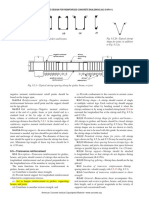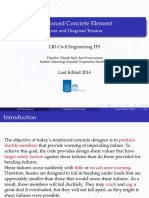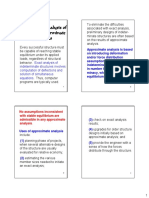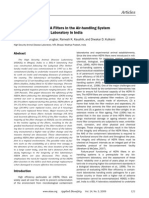Lecture 17 - Design of Reinforced Concrete Beams For Shear: November 1, 2001 CVEN 444
Uploaded by
Ram RamisettiLecture 17 - Design of Reinforced Concrete Beams For Shear: November 1, 2001 CVEN 444
Uploaded by
Ram RamisettiLecture 17 - Design of Reinforced
Concrete Beams for Shear
November 1, 2001
CVEN 444
Lecture Goals
Stirrup Design
Uncracked Elastic Beam
Behavior
Look at the shear and
bending moment
diagrams. The acting
shear stress distribution
on the beam.
Uncracked Elastic Beam
Behavior
The acting stresses distributed
across the cross-section.
The shear stress acting on
the rectangular beam.
Ib
VQ
= t
Uncracked Elastic Beam
Behavior
The equation of the shear stress for a rectangular beam is given as:
Note: The maximum 1st
moment occurs at the neutral
axis (NA).
Ib
VQ
= t
ave max
2
max
3
5 . 1 *
2
3
8 4
*
2
Q
Inertia of Moment
12
t t =
|
.
|
\
|
=
=
|
.
|
\
|
|
.
|
\
|
=
=
bh
V
bh h bh
bh
I
Uncracked Elastic Beam
Behavior
The ideal shear stress distribution can be described as:
Ib
VQ
= t
Uncracked Elastic Beam Behavior
A realistic description of the shear distribution is shown as:
Uncracked Elastic Beam Behavior
The shear stress acting along the beam can be described with a
stress block:
Using Mohrs circle, the stress block can be manipulated to
find the maximum shear and the crack formation.
Inclined Cracking in Reinforced
Concrete Beams
Typical Crack Patterns for a deep beam.
Inclined Cracking in Reinforced
Concrete Beams
Flexural-shear crack - Starts
out as a flexural crack and
propagates due to shear
stress.
Flexural cracks in beams are
vertical (perpendicular to the
tension face).
Inclined Cracking in Reinforced
Concrete Beams
For deep beam the cracks are
given as:
The shear cracks Inclined
(diagonal) intercept crack with
longitudinal bars plus vertical
or inclined reinforcement.
Inclined Cracking in Reinforced
Concrete Beams
For deep beam the cracks are
given as:
The shear cracks fail due two
modes:
- shear-tension failure
- shear-compression failure
Shear Strength of RC Beams
without Web Reinforcement
v
cz
- shear in compression
zone
v
a
- Aggregate Interlock
forces
v
d
= Dowel action from
longitudinal bars
Note: v
cz
increases from
(V/bd) to (V/by) as crack
forms.
Total Resistance = v
cz
+ v
ay
+v
d
(when no stirrups are used)
Strength of Concrete in Shear
(No Shear Reinforcement)
(1) Tensile Strength of concrete affect inclined
cracking load
(2) Longitudinal Reinforcement Ratio,
w
( )
d b f V
d b
A
w c c w
w
s
w
2 : 0025 . 0 0075 . 0 for
cracks restrains
'
~ s s
=
Strength of Concrete in Shear
(No Shear Reinforcement)
(3) Shear span to depth ratio, a/d (M/(Vd))
effect little has Rato 2
d
a
required design detail more spans shear deep 2
>
s
d
a
Strength of Concrete in Shear
(No Shear Reinforcement)
(4) Size of Beam
Increase Depth Reduced shear stress at
inclined cracking
(5) Axial Forces
- Axial tension Decreases inclined cracking load
- Axial Compression Increases inclined cracking
load (Delays flexural
cracking)
Function and Strength of Web
Reinforcement
Web Reinforcement is provided to ensure that
the full flexural capacity can be developed.
(desired a flexural failure mode - shear failure
is brittle)
- Acts as clamps to keep shear cracks from
widening
Function:
Function and Strength of Web
Reinforcement
Uncracked Beam Shear is resisted
uncracked concrete.
Flexural Cracking Shear is resisted by
v
cz
, v
ay
, v
d
bars. al longitudin from Action Dowl
force Interlock Aggregate of component Vertical
zone n compressio in Shear
d
ay
cz
V
V
V
Function and Strength of Web
Reinforcement
Flexural Cracking Shear is resisted by
v
cz
, v
ay
, v
d
and v
s
V
s
increases as cracks
widen until yielding of
stirrups then stirrups
provide constant
resistance.
Designing to Resist Shear
Shear Strength (ACI 318 Sec 11.1)
demand capacity >
>
u n
V V |
( ) factor reduction strength shear 0.85
Strength Shear Nominal
section at force shear factored
=
=
=
|
n
u
V
V
s c n
V V V + =
ent reinforcem shear by the provided shear Nominal
concrete by provided resistance shear Nominal
=
=
s
c
V
V
Shear Strength Provided by Concrete
Lightweight Concrete:
Shear Strength Provided by Shear Reinforcement
Minimum Shear Reinforcement: (11.5.5)
c u
V V
2
1
when quired Re | >
( )
( )
( )
s
w
f
b 1/2
t 2.5
10"
of larger h with Beams c
8.11) (defined on Constructi Joist Concrete b
Footings & Slabs a
Except
Lightweight Concrete:
Shear Strength Provided by Shear Reinforcement
( )
( ) inches in , b 50
w min
s
f
s b
A
y
w
v
=
(provides additional 50 psi of shear strength)
( )
( )
concrete weight standard for for 85 . 0 substitute can or
concrete t lightweigh - all for for 75 . 0 substitute can 2
for 7 . 6 / substitute can 1
c c
c c
c c ct
f f
f f
f f f s
Note:
stirrups. for psi 60000 s
y
f
(11.2) concrete
t Lightweigh for
c
V
strength tensile splitting =
ct
f
Typical Shear Reinforcement
Stirrup - perpendicular to axis
of members
(minimum labor - more
material)
( )
15) - 11 eqn (ACI ; 90
cos sin
s
d f A
V
s
d f A
V
y v
s
y v
s
= =
+
=
o
o o
Typical Shear Reinforcement
Bent Bars (more labor -
minimum material) see
reqd in 11.5.6
( )
5.6) - 11 (ACI
41 . 1
; 45
45 cos 45 sin
s
d f A
V
s
d f A
V
y v
s
y v
s
= =
+
=
o
Stirrup Anchorage Requirements
V
s
based on assumption stirrups yield
Stirrups must be well anchored.
Refer to Sec. 12.12 of ACI 318 for development
of web reinforcement. Requirements:
- each bend must enclose a long bar
- # 5 and smaller can use standard hooks 90
o
,135
o
, 180
o
- #6, #7,#8(f
y
= 40 ksi)
- #6, #7,#8(f
y
> 40 ksi) standard hook plus a min embedment
Also sec. 7.11 requirement for min. stirrups in beams with
compression reinforcement, beams subject to stress reversals, or
beams subject to torsion
Design Procedure for Shear
(1) Calculate V
u
(2) Calculate |V
c
Eqn 11-3 or 11-5 (no axial force)
(3) Check
>
done. no, If
4) to (go ent reinforcem web add yes, If
2
1
is
c u
V V |
Design Procedure for Shear
(4)
ent reinforcem shear
minimum provide ,
2
1
If
c u c
V V V | | s s
( )
|
|
.
|
\
|
= =
v
w
ys v
y
w
v
A
b
f A
s
f
s b
A min for
50
or 50
max min
Also:
(Done)
( ) 11.5.4 " 24
2
max
s s
d
s
Design Procedure for Shear
(5)
c
u
s c u s
s c n u
s c u
V
V
V V V V
V V V V
V V V
= =
+ = s
>
|
| |
| | |
| d) (req' calulate , If
Check:
( ) ( ) 11.5.4 illegal otherwise, 8 d b f V
w c s
'
s
Design Procedure for Shear
(6) Solve for required stirrup spacing(strength) Assume
# 3, #4, or #5 stirrups
(7) Check minimum steel requirement (eqn 11-13)
( ) 15 - 11 from
s
ys v
V
d f A
s s
50
max
w
ys v
b
f A
s =
Design Procedure for Shear
(8) Check maximum spacing requirement (ACI 11.5.4)
(9) Use smallest spacing from steps 6,7,8
( ) illegal 8 If : Note
" 12
4
4 If
" 24
2
4 If
c
max c
max c
d b f V
d
s d b f V
d
s d b f V
w s
w s
w s
'
>
s s
'
>
s s
'
s
Note: A practical limit to minimum stirrup
spacing is 4 inches.
Location of Maximum Shear for
Beam Design
Non-pre-stressed members:
Sections located less than a distance d from
face of support may be designed for same
shear, V
u
, as the computed at a distance d.
Compression fan carries
load directly into support.
Location of Maximum Shear for
Beam Design
The support reaction introduces compression
into the end regions of the member
No concentrated load occurs with in d from
face of support .
1.
2.
When:
Location of Maximum Shear for
Beam Design
Compression from support at
bottom of beam tends to
close crack at support
Example: Design of Stirrups to Resist Shear
f
c
= 4000 psi
f
y
= 60 ksi
w
sdl
=1.2 k/ft
w
ll
= 1.8 k/ft
f
ys
= 40 ksi
w
b
= 0.5 k/ft
From flexural design:
will use either a #3 or #4 stirrup
You might also like
- ICE Manual of Structural Engineering 117No ratings yetICE Manual of Structural Engineering 1171 page
- An Enhanced Simulation Model For Building Envelopes With Phase Change MaterialsNo ratings yetAn Enhanced Simulation Model For Building Envelopes With Phase Change Materials10 pages
- Chartered Membership Examination: Thursday, 5 July 2018No ratings yetChartered Membership Examination: Thursday, 5 July 201818 pages
- Fig. 8.5.2a-Typical Stirrup Shapes For Girders and Beams. Fig. 8.5.2b-Typical Stirrup Shape For Joists, in Addition To Fig. 8.5.2aNo ratings yetFig. 8.5.2a-Typical Stirrup Shapes For Girders and Beams. Fig. 8.5.2b-Typical Stirrup Shape For Joists, in Addition To Fig. 8.5.2a4 pages
- Electric Lift Installations Steel Frame Buildings: PublicationNo ratings yetElectric Lift Installations Steel Frame Buildings: Publication0 pages
- Critical Beam, Slab, Colum, Staircae Design100% (1)Critical Beam, Slab, Colum, Staircae Design23 pages
- Seismic Response Analysis of Multi-Span Isolated Bridges: A Case StudyNo ratings yetSeismic Response Analysis of Multi-Span Isolated Bridges: A Case Study150 pages
- Elements of Steel Structure: Aniendhita Rizki Amalia, ST. MTNo ratings yetElements of Steel Structure: Aniendhita Rizki Amalia, ST. MT36 pages
- Chartered Membership Examination: Monday 7 September 2020100% (1)Chartered Membership Examination: Monday 7 September 202016 pages
- Reinforced Concrete Design by Professor Anthony Kwame DansoNo ratings yetReinforced Concrete Design by Professor Anthony Kwame Danso131 pages
- Progressive Collapse Resistance of Axially-RestrainedNo ratings yetProgressive Collapse Resistance of Axially-Restrained8 pages
- Lecture 1-Introduction To Structural EngineeringNo ratings yetLecture 1-Introduction To Structural Engineering23 pages
- Structural Analysis - Approximate AnalysisNo ratings yetStructural Analysis - Approximate Analysis8 pages
- Pre Stressed Concrete Is A Method For Overcoming The ConcreteNo ratings yetPre Stressed Concrete Is A Method For Overcoming The Concrete7 pages
- Seismic Force Resisting Systems and Response of Concrete BuildingNo ratings yetSeismic Force Resisting Systems and Response of Concrete Building30 pages
- Institution of Structural Engineers Part 3 Exam: Paul MartinNo ratings yetInstitution of Structural Engineers Part 3 Exam: Paul Martin20 pages
- Cracks in Buildings: Causes, Effects, and Remediation StrategiesNo ratings yetCracks in Buildings: Causes, Effects, and Remediation Strategies13 pages
- Chartered Membership (Part 3) Examination: (Old Examination Format For Reference Only)No ratings yetChartered Membership (Part 3) Examination: (Old Examination Format For Reference Only)16 pages
- Reinforced Concrete Drafting: Helping Turn Ideas Into Reality100% (1)Reinforced Concrete Drafting: Helping Turn Ideas Into Reality33 pages
- ST5001-Maintenance Rehabilitation of Structures PDFNo ratings yetST5001-Maintenance Rehabilitation of Structures PDF12 pages
- A Catalogue of Details on Pre-Contract Schedules: Surgical Eye Centre of Excellence - KathFrom EverandA Catalogue of Details on Pre-Contract Schedules: Surgical Eye Centre of Excellence - KathNo ratings yet
- Lecture 17 - Design of Reinforced Concrete Beams For Shear: November 1, 2001 CVEN 444No ratings yetLecture 17 - Design of Reinforced Concrete Beams For Shear: November 1, 2001 CVEN 44435 pages
- Lecture 21 - Splices and Shear: February 5, 2003 CVEN 444No ratings yetLecture 21 - Splices and Shear: February 5, 2003 CVEN 44458 pages
- Multitasking: Productivity Effects and Gender Differences: Thomas Buser Noemi PeterNo ratings yetMultitasking: Productivity Effects and Gender Differences: Thomas Buser Noemi Peter12 pages
- The Surest Indicator of A Great Nation Is Represented Not by The Achievements of Its RulersNo ratings yetThe Surest Indicator of A Great Nation Is Represented Not by The Achievements of Its Rulers1 page
- Indian Standards and Codes: Standard Topics Fire ExtinguishersNo ratings yetIndian Standards and Codes: Standard Topics Fire Extinguishers2 pages
- Building Information Modelling (BIM) Working Party Strategy Paper, March 2011No ratings yetBuilding Information Modelling (BIM) Working Party Strategy Paper, March 2011107 pages
- An Enhanced Simulation Model For Building Envelopes With Phase Change MaterialsAn Enhanced Simulation Model For Building Envelopes With Phase Change Materials
- Chartered Membership Examination: Thursday, 5 July 2018Chartered Membership Examination: Thursday, 5 July 2018
- Fig. 8.5.2a-Typical Stirrup Shapes For Girders and Beams. Fig. 8.5.2b-Typical Stirrup Shape For Joists, in Addition To Fig. 8.5.2aFig. 8.5.2a-Typical Stirrup Shapes For Girders and Beams. Fig. 8.5.2b-Typical Stirrup Shape For Joists, in Addition To Fig. 8.5.2a
- Electric Lift Installations Steel Frame Buildings: PublicationElectric Lift Installations Steel Frame Buildings: Publication
- Seismic Response Analysis of Multi-Span Isolated Bridges: A Case StudySeismic Response Analysis of Multi-Span Isolated Bridges: A Case Study
- Elements of Steel Structure: Aniendhita Rizki Amalia, ST. MTElements of Steel Structure: Aniendhita Rizki Amalia, ST. MT
- Chartered Membership Examination: Monday 7 September 2020Chartered Membership Examination: Monday 7 September 2020
- Reinforced Concrete Design by Professor Anthony Kwame DansoReinforced Concrete Design by Professor Anthony Kwame Danso
- Progressive Collapse Resistance of Axially-RestrainedProgressive Collapse Resistance of Axially-Restrained
- Pre Stressed Concrete Is A Method For Overcoming The ConcretePre Stressed Concrete Is A Method For Overcoming The Concrete
- Seismic Force Resisting Systems and Response of Concrete BuildingSeismic Force Resisting Systems and Response of Concrete Building
- Institution of Structural Engineers Part 3 Exam: Paul MartinInstitution of Structural Engineers Part 3 Exam: Paul Martin
- Cracks in Buildings: Causes, Effects, and Remediation StrategiesCracks in Buildings: Causes, Effects, and Remediation Strategies
- Chartered Membership (Part 3) Examination: (Old Examination Format For Reference Only)Chartered Membership (Part 3) Examination: (Old Examination Format For Reference Only)
- Reinforced Concrete Drafting: Helping Turn Ideas Into RealityReinforced Concrete Drafting: Helping Turn Ideas Into Reality
- ST5001-Maintenance Rehabilitation of Structures PDFST5001-Maintenance Rehabilitation of Structures PDF
- A Catalogue of Details on Pre-Contract Schedules: Surgical Eye Centre of Excellence - KathFrom EverandA Catalogue of Details on Pre-Contract Schedules: Surgical Eye Centre of Excellence - Kath
- Lecture 17 - Design of Reinforced Concrete Beams For Shear: November 1, 2001 CVEN 444Lecture 17 - Design of Reinforced Concrete Beams For Shear: November 1, 2001 CVEN 444
- Lecture 21 - Splices and Shear: February 5, 2003 CVEN 444Lecture 21 - Splices and Shear: February 5, 2003 CVEN 444
- Multitasking: Productivity Effects and Gender Differences: Thomas Buser Noemi PeterMultitasking: Productivity Effects and Gender Differences: Thomas Buser Noemi Peter
- The Surest Indicator of A Great Nation Is Represented Not by The Achievements of Its RulersThe Surest Indicator of A Great Nation Is Represented Not by The Achievements of Its Rulers
- Indian Standards and Codes: Standard Topics Fire ExtinguishersIndian Standards and Codes: Standard Topics Fire Extinguishers
- Building Information Modelling (BIM) Working Party Strategy Paper, March 2011Building Information Modelling (BIM) Working Party Strategy Paper, March 2011








































































